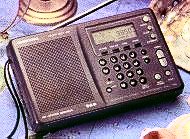
Year Introduced: 1994 (NA-centric PE version 4th Q 1998)
Power: 9 vDC (6 AA), AC adaptor optional (included in PE version)
Size: 180 x 120 x 37 mm
Weight: 600g
Price: US$149.95, CAN$250, £105, A$400, £120.00, €195
Coverage: 144-351 kHz, 520-1710 kHz, 1.711-30 MHz, FM 87.5-108 MHz
Value Rating star:





This review was compiled independently. The Medium Wave Circle and Radio Netherlands has no financial connection with R.L. Drake, the manufacturer of this receiver.
Reviewers: Jonathan Marks, Diana Janssen, and Willem Bos.
The Yacht Boy 400 was launched at the end of 1993 in North America. In fact at £105 across Europe, the Yacht Boy 400 turns out to be a great value package. Our example is clearly made for Grundig in the Peoples’ Republic of China. Grundig has designed the unit and supervised the quality control. The Yacht Boy 400 looks like many travel portables. At 180 by 120 by 37 millimetres, the set is about the size of a paperback book, it works off six penlight batteries and weighs 708 grams with batteries.
Despite a rather clumsy instruction booklet literally translated from German, if you practice a little, the Yacht Boy 400 is extremely easy to use. You simply tap in the desired frequency and press a button. Two buttons allow you to shuttle up and down the dial and on shortwave you can flip between 5 kHz steps and 1 kHz. The radio offers two bandwidths, and both filters have a good shape factor for a portable radio. The speaker is closely matched to the cabinet, so the radio sounds much richer and fuller than competing sets from Japan.
The radio turns out to be sensitive, without serious problems of overloading here in Europe. You can store up 40 stations in the memory and using a separate set of up-down buttons you can flip through the active memory channels with ease. Like most radios, the set will scan through the dial stopping at stronger, listenable signals.
Clearly some compromises have had to be made to keep the price down. You can receive signal sideband using the radio, but clarification of either the upper or lower sideband is by means of a thumbwheel rather than the push of a button. The radio also has no synchronous detection, but the sharp bandwidth filters in Grundig, which come out at 5.5 and 3 kHz at -6dB, are a strong plus point.
FM coverage is between 87.5 and 108 MHz, with stereo possible if you connect the pair of earphones. The sensitivity on FM is about right for Europe… may be a little too sensitive for cities in North America where the FM dial is crowded. You can connect an external antenna for areas where shortwave signals are relatively weak. The radio is supplied with a washing-line antenna, though you don’t really need it in Europe. The dial light can be illuminated for bed-side listening, the set has two clocks for keeping track of both local time and UTC and a recessed lock switch to prevent accidental battery drain when the radio is put in a suitcase. We got just over 20 hours of listening from a fresh set of alkaline batteries, listening for periods of an hour a day. That’s not bad, but running the set off the mains is a lot cheaper. A mains power supply is not included as part of the package though.
In short, Grundig has made a superb portable. They would do well to re-write the instruction manual and supply more up to date schedule information… the one packed with our radio was clearly compiled nearly four years ago. Overall, this set is a good value, and it sounds very good.
The Grundig Yacht Boy 400 won the 1994 World Radio TV Handbook Industry Award for Best Shortwave Portable.
In North America, Lextronix released the titanium-coloured finish YB-400PE (Professional Edition) in the fourth quarter of 1998. Electrically, there is no difference between the YB-400 and YB-400PE. A Grundig-brand AC adapter is included, as are stereo ear plugs, wind-up antenna, a re-written owners manual and vinyl carry case. The out-of-date schedule information has been dropped in lieu of sources of information on broadcasters and schedules.
This review first appeared on the Radio Netherlands website.